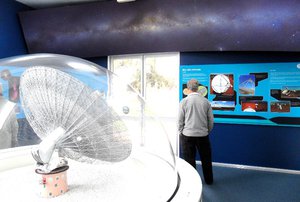Advertisement

 CSIRO's Parkes Radio Telescope Discovery Centre
CSIRO's Parkes Radio Telescope Discovery Centre
A model of the dish moved to point at each of five pulsars in the night sky above the window, as you pushed the buttons. You then heard the sound that one makes and they are all different.Got up early today and put on 2 loads of washing (they only have 2 machines) to do while I had breakfast and then hung it up. We then set off for the CSIRO’s Parkes Radio Telescope, otherwise known as “The Dish” after the movie made in 2000, in which it featured. (The movie told the slightly fictionalised story of Parkes telescope receiving pictures of the Apollo 11 first Moon landing. And no, they didn’t play cricket on the dish, although the actors did for the movie – using a tennis ball only).
As we pulled up in the car park we were bombarded with a lot of chattering, which turned out to be coming from a squabbling group of Apostle Birds. There were also 3 White Winged Choughs with their easily identifiable red eyes. Signs along the path to the entrance asked us to turn off all electronic devices or put them into flight mode so they didn’t interfere with the telescope’s radio reception.
Inside the Discovery Centre were lots of very well explained and illustrated information boards and even a little replica of the telescope, which pointed to a “night sky” painted high on the back wall.

 CSIRO Parkes Radio Telescope
CSIRO Parkes Radio Telescope
The little figure on the left is Barry, which just shows how huge it is.It had five buttons labelled each with a different pulsar’s name on it. When you pushed the button, the telescope swung around and located the pulsar in the night sky painting and you then heard the sound that particular one makes as picked up by the telescope. It was very surprising how different they were from each other. Two sounded a bit like static “snow” at different pitches but with regular pulses; one had a slow, steady beat; one sounded like a lawn mower motor idling and the last raced along like a motorbike under power.
The telescope was built in 1961 but only its basic structure is still the same. The surface, the focus cabin at the top and the equipment have all been upgraded several times so that it is now 10,000 times more sensitive than it was originally. The dish has a diameter of 64 metres and it is 58 metres up to the focus cabin at the top. It takes 5 minutes to go to its maximum tilt of 60 degrees from the vertical and 15 minutes for a complete rotation. Being such a big surface area, it doesn’t like high winds so anything over

 A Grey Butcherbird
A Grey Butcherbird
He decided to check out the picnic area in the grounds of the Parkes Radio Telescope .35 kph requires the dish to be parked horizontally for safety (although winds were gusting up to 100 kph on the day of the Apollo 11 Moonwalk but they did operate – a one off event!)
We then went and had a delicious lunch at the cafe there. I had a Quasar Quiche (sweet potato and onion – delicious) and Barry had a Beef and Red Wine Pie with large chunks of good steak and a really thick rich gravy. He enjoyed it so much I bought another and a chicken and mushroom one for me to take back to the van for another day. We finished with an excellent scone each, topped with home-made fig jam and cream – luxury! We were looking directly at the telescope through the window as we ate and could see it slowly moving. What a view – don’t see that every time you have lunch.
We then went back to take the washing off the line and I then had a quick look at the Henry Parkes Centre (Barry wasn’t interested) where there was “The King’s Castle” (a collection of Elvis Presley artefacts such as furniture from one of his houses,

 A White-Winged Chough
A White-Winged Chough
This was one of three foraging in the grounds of the Parkes Radio Telescope. It is the same kind of bird we saw at Buchan Caves earlier in the year and is easily recognisable by its red eyes.one of his costumes and a few personal effects, like jewellery and books) which took you through one day in the life of Elvis on tour. Unfortunately, I was rather underwhelmed by the presentation – just as well Barry hadn’t come. There was also another Motor Museum with cars and motorbikes owned by members of the Parkes Antique Motor Club and dating from 1914 to 1986 (a good way to have a place to keep your car and get some money for the club, I imagine, while allowing others to enjoy the memories). I was most interested in the 1971 Morris Minor Traveller with the wooden struts on the “hatch” end because that was our family’s first car when my mother got her driving licence. I haven’t seen one for years.
Then back to the van for left-over pizza and postcard writing.
Advertisement
Tot: 0.065s; Tpl: 0.011s; cc: 11; qc: 35; dbt: 0.0376s; 1; m:domysql w:travelblog (10.17.0.13); sld: 1;
; mem: 1.1mb

 CSIRO's Parkes Radio Telescope Discovery Centre
CSIRO's Parkes Radio Telescope Discovery Centre
 CSIRO Parkes Radio Telescope
CSIRO Parkes Radio Telescope
 A Grey Butcherbird
A Grey Butcherbird
 A White-Winged Chough
A White-Winged Chough



Snap Shot Stacey
Snap Shot Stacey
It remind me a bit of Jodrell Bank (though smaller)